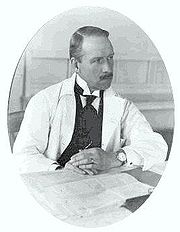
Karel Frederik Wenckebach
Encyclopedia

The Hague
The Hague is the capital city of the province of South Holland in the Netherlands. With a population of 500,000 inhabitants , it is the third largest city of the Netherlands, after Amsterdam and Rotterdam...
. He studied medicine in Utrecht
Utrecht (city)
Utrecht city and municipality is the capital and most populous city of the Dutch province of Utrecht. It is located in the eastern corner of the Randstad conurbation, and is the fourth largest city of the Netherlands with a population of 312,634 on 1 Jan 2011.Utrecht's ancient city centre features...
, and in 1901 become a professor of medicine at the University of Groningen
University of Groningen
The University of Groningen , located in the city of Groningen, was founded in 1614. It is one of the oldest universities in the Netherlands as well as one of its largest. Since its inception more than 100,000 students have graduated...
. Later he was a professor at the Universities of Strasbourg
University of Strasbourg
The University of Strasbourg in Strasbourg, Alsace, France, is the largest university in France, with about 43,000 students and over 4,000 researchers....
(1911-14) and Vienna
University of Vienna
The University of Vienna is a public university located in Vienna, Austria. It was founded by Duke Rudolph IV in 1365 and is the oldest university in the German-speaking world...
(1914-29).
Wenckebach is primarily remembered for his work in cardiology
Cardiology
Cardiology is a medical specialty dealing with disorders of the heart . The field includes diagnosis and treatment of congenital heart defects, coronary artery disease, heart failure, valvular heart disease and electrophysiology...
. In 1899 he provided a description of irregular pulses due to partial blockage of atrioventricular
Atrioventricular
Atrioventricular can refer to:*Left atrioventricular opening*Atrioventricular fistula*Atrioventricular node*The term "Atrioventricular valves" is used to describe the mitral valve and tricuspid valve....
conduction which created a progressive lengthening of conduction time in cardiac tissue. This condition was referred to as a "second degree AV block" (Mobitz Type I), and later named the Wenckebach phenomenon.
Wenckebach is also credited for describing the median bundle of the heart's conductive system that leads to the atrioventricular node
Atrioventricular node
The atrioventricular node is a part of the electrical control system of the heart that coordinates heart rate. It electrically connects atrial and ventricular chambers...
. This bundle was named Wenckebach's bundle, and is one of four internodal pathways, the others being; the posterior internodal tract (Thorel's pathway), and the two branches of the anterior internodal tract (Bachmann's bundle
Bachmann's bundle
right|thumb|350px|Image showing Bachmann's bundleBachmann's bundle, also known as the anterior interatrial band, is a broad band of atrial muscle that runs just behind the ascending aorta and connects the top of the right atrium with the top of the left atrium. Bachmann's bundle is, during normal...
plus a descending branch). Wenckebach was also an early advocate regarding the use of quinine
Quinine
Quinine is a natural white crystalline alkaloid having antipyretic , antimalarial, analgesic , anti-inflammatory properties and a bitter taste. It is a stereoisomer of quinidine which, unlike quinine, is an anti-arrhythmic...
for treatment of paroxysmal atrial fibrillation
Atrial fibrillation
Atrial fibrillation is the most common cardiac arrhythmia . It is a common cause of irregular heart beat, identified clinically by taking a pulse. Chaotic electrical activity in the two upper chambers of the heart result in the muscle fibrillating , instead of achieving coordinated contraction...
.
Family
His father Eduard (1813-1874) has been credited with developing the very first telegraphic communications line in the Netherlands, between Haarlem and Amsterdam. He had two brothers, Henri Johan Eduard (1861-1924), director of the State Mines and later of the Dutch Ironworks in IJmuiden and Ludwig Willem Reymert (1860-1937), a well known painter and book illustrator.His son Oswald became a sculptor, painter and medallist, most widely known for his war monuments and designing the Dutch coins issued between 1948 and 1981.
Selected writings
- Arythmie als Ausdruck bestimmter Funktionsstörungen des Herzens (1903, Engelse vertaling: (1904)
- Die unregelmässige Herztätigkeit und ihre klinische Bedeutung (1914)
- Herz- und Kreislaufinsufficienz (1931)

